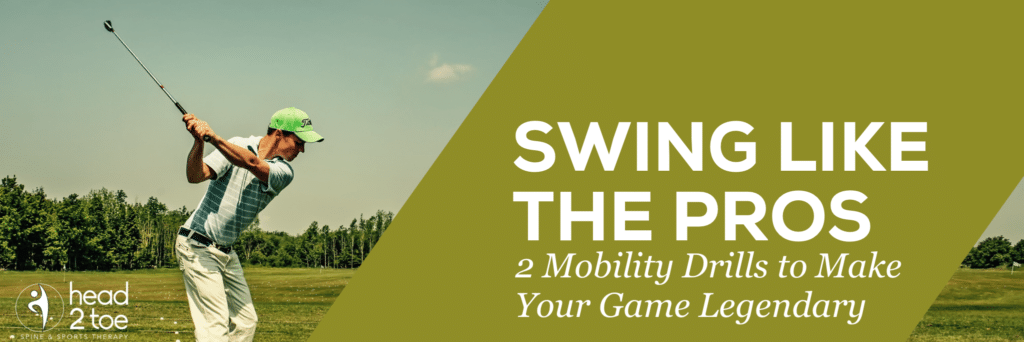
Most golfers know that they need to keep their shoulders, wrists and hips mobile to maintain a consistent, competitive and pain-free golf game. But few golfers know the importance of spinal mobility. In particular, thoracic spine mobility.
The thoracic spine is the area of your back attached to your rib cage. It starts at the base of your neck and ends at the bottom of your rib cage, which is the upper part of your waist. Spinal mobility is dependent on each vertebrae moving independently over the next one. In my practice, 90 percent of the patients I see have limited thoracic spine mobility.
Over half of your backswing comes from thoracic rotation.
When your thoracic spine rotation is reduced, your swing will be compromised. That can lead to injuring your shoulders and low back.
Our body loses thoracic mobility for two main reasons. The first reason is due our increasingly sedentary lifestyle. The second reason is because most motions we do in life are in the front of our body, using a pushing motion more than a pulling motion. As a result, we get what us chiropractors call “upper cross syndrome” with its characteristic stooped posture, rounded shoulders, and a forward bent neck. This postural characteristic greatly reduces the amount of spinal rotation and limits the ability to create a good turn in the backswing.
How to know if you have decreased thoracic spine mobility.
Here is a Seated Trunk Rotation Test developed by Dr. Greg Rose and the wizards at the Titelist Performance Institute. Keep in mind, a self-assessment is not as thorough as seeing a professional, but it will help you feel your limitations. When you are ready for a full assessment of your movement as it relates to golf, a great option is to see a TPI certified provider like Dr. Annie Armstrong at Head 2 Toe Spine and Sports Therapy. In the meantime, do this simple test to see where you are at.
- Place two golf clubs on the ground at 45-degree angles on either side of your position. These will be used as reference to measure your rotation.
- Sit in an upright position with your knees and feet together. Place another golf club across your shoulders and hold it with your arms in a “W” position.
- Using the thoracic area of your spine, rotate both to the right and to the left as far as possible. See if you can rotate past the 45-degree range marked by your golf clubs on the ground.
Many golfers compensate by rotating their shoulder blades back and forth. This gives the appearance of having a good shoulder turn, but they actually lack true thoracic spine rotation. Holding the golf club on your shoulders locks your shoulder blades so you can access your true thoracic rotation for a real picture of your spinal mobility.
Here’s what can you do about it:
- Perform thoracic mobility drills on a foam roller.

Position 1:
Sit in front of the roller, with your hands behind your neck, head completely relaxed into your hands. Lean back over the roller, slowly moving from the top of your shoulder blades to halfway down your back. Lift your booty up slightly off the ground and roll your spine looking for the sore spots. When you have found a sore spot, relax into it and trigger point it. Tilt side to side, whatever feels good. It may be uncomfortable – this is normal in the beginning.
Position 2:
Lay the long way on the roller. Hold your arms out to the sides with your elbows bent at 90 degrees. Let gravity pull your arms towards the ground, feeling a stretch in the front of your chest.
2. Actively stretch your thoracic spine with the Open Book exercise.
This is a fantastic exercise for increasing your thoracic mobility. And it feels great!

When to bring in a mobility pro
If you are experiencing shoulder pain, neck discomfort, low back pain, or you just can’t hit the ball as well and far as you would like to then you have a mobility problem.
If you want help taking your golf game up, we can help. We are certified in the TPI golf swing and the SFMA full body functional movement screen.
The best part is we know how to fix these golf-related mobility limitations!
We are master mobilizers and guarantee we can help you achieve greater mobility. Call us at (425) 776-2936 or visit our New Patients page to take the first steps towards improving your swing today.
Exercises You Can Do at Home after a Visit to the Chiropractic Clinic
Stay active at home with exercises from ‘Exercises You Can Do at Home after a Visit to the Chiropractic Clinic’.
Read MoreAthletic Therapy: A Vital Component in Sports Rehabilitation
Discover the importance of athletic therapy in sports rehabilitation in our insightful blog on ‘Athletic Therapy: A Vital Component in Sports Rehabilitation’.
Read MoreA Comprehensive Guide to Spinal Therapy for Athletes
Discover the benefits of spinal therapy for athletes in our comprehensive guide ‘A Comprehensive Guide to Spinal Therapy for Athletes’.
Read MoreHow Chiropractic Techniques are Advancing in Pain and Injury Treatment
Discover the latest advancements in pain and injury treatment through innovative chiropractic techniques.
Read MoreSpine Rehabilitation: How Corrective Exercises Can Help with Posture and Pain Relief
Discover how corrective exercises in spine rehabilitation relieve pain and improve posture – read more now!
Read MoreCorrective Exercises: Your Secret Weapon Against Chronic Pain
Combat chronic pain with corrective exercises featured in ‘Corrective Exercises: Your Secret Weapon Against Chronic Pain’.
Read More




